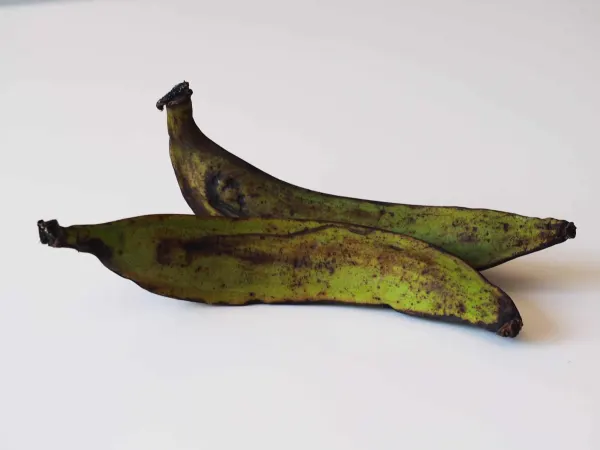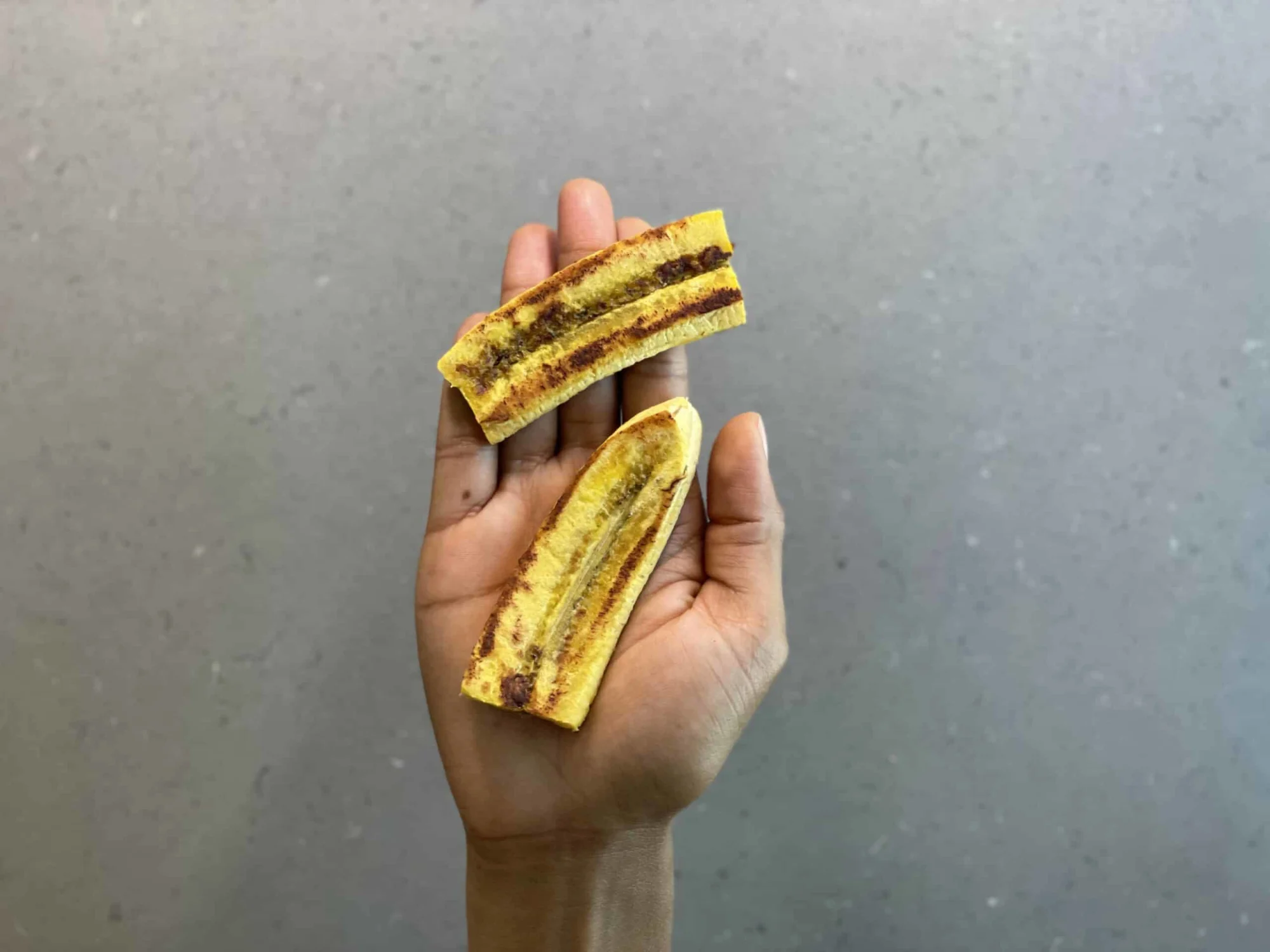Plantain
Fruit
Age Suggestion
6 months
Iron-Rich
No
Common Allergen
No

When can babies eat plantains?
Plantains may be introduced as soon as a baby is ready to start solids, which is generally around 6 months of age. While plantains are delicious when deep fried, opt for baked or boiled plantains for babies and hold off on fried plantains until a child is older.
Background and origins of plantain
Plantains are a type of banana, with more starch, an earthier taste, and just a touch of sweetness that becomes more pronounced as they ripen. While plantains can technically be eaten raw when they are very ripe, the fruit is called a “cooking banana” for a reason. It is most often prepared like a vegetable… specifically, like a potato—boiled and mashed, steamed and grilled, smashed and fried, sliced and baked—almost always with aromatic seasoning from alliums, herbs, and spices.
Plantains originated in the tropics of Asia, where colonizers took the fruit to Africa and later to the Americas, where it flourishes today. Around the world, the fruit is used to make breakfast, lunch, dinner, and even dessert. In Ghana, plantains are marinated in savory spices to make kelewele; in Cuba, fufu features boiled and mashed plantains mixed with sofrito; in Nicaragua, fried plantains show up with stewed meats, rice, and beans on heaping plates called frittanga; and in the Philippines, plantains are battered and fried to make sweet fritters called maruya.
★Tip: When reading recipes, pay attention to a plantain’s stage of ripeness. Green plantains are hard and extra starchy and cannot necessarily be swapped for sweet plantains which, over time, become mottled with brown spots as they ripen, and eventually turn black—a sign of peak sweetness. Make sure to store plantains at room temperature to ripen. Once they are black, transfer the fruit to the fridge to extend the shelf life. Once peeled, they can be frozen for up to a month.
Videos
Are plantains healthy for babies?
Yes. The fruit contains plenty of carbohydrates and important nutrients to help babies thrive. Plantains are packed with B vitamins, including B6 and folate, to help babies turn food into energy and grow their cells and tissues. They also contain some vitamin A to strengthen babies’ eyesight, skin, and immune system, and vitamin C to help babies absorb iron and develop a strong immune system. Plus, they are a rich source of fiber that can promote a healthy digestive system by cultivating friendly bacteria in a baby’s gut.
Plantains are often processed to create food products like chips, fries, and tostones—delicious twice-fried rounds of green plantains—and their sweeter fried cousins, maduros. Many preparations of plantains involve frying in oil. However, the high heat of frying can lead to undesirable changes in the oil/fat quality such as the creation of trans fats and free radicals. Plus, fried food, including plantains, tends to be accompanied by quite a bit of salt. If fried plantains are part of your family's food culture, consider offering more boiled or baked, lightly salted (or unsalted) plantains to babies, and once a child is old enough to handle the challenging consistency of fried plantains, offer in moderation.
Plantain flour is a nutritious product for babies and toddlers, especially in gluten-free families. Made with starchy green plantains, the flour contains fiber and vitamins, and when it’s processed from both the flesh and the peel, it offers calcium, iron, and antioxidants.
★Tip: As with many fruits picked before peak ripeness, plantains often are artificially ripened and, as a result, may contain chemical residues. Plantains also tend to be heavily sprayed with pesticides, affecting families on or near plantations. Washing plantains before slicing may help reduce pesticide exposure. For those with more bandwidth in their budget, consider choosing organic and/or fair-trade plantains to support smaller plantain producers and their families.
Are plantains a common choking hazard for babies?
No, though certain preparations of plantains (such as tostones or plantain chips) can be. As always, be sure to create a safe eating environment and stay near baby during mealtime.
For more information on choking, visit our sections on gagging and choking and familiarize yourself with the list of common choking hazards.
Are plantains a common allergen?
No. Plantains are not a common allergen, although individuals with ragweed allergy, latex allergy, or oral allergy syndrome (also called pollen food allergy syndrome) may be sensitive to plantains and bananas. Oral allergy syndrome typically presents as a mild and temporary itching in the mouth, which usually resolves on its own. However, oral allergy symptoms tend not to be a problem when the plantain is cooked before serving. People who are allergic to bananas may also be allergic to plantains as the fruits are part of the same plant family.
As you would when introducing any new food, start by offering a small quantity on its own for the first couple of servings. If there is no adverse reaction, gradually increase the quantity over future meals.
How do you prepare plantain for babies with baby-led weaning?
Every baby develops on their own timeline, and the suggestions on how to cut or prepare particular foods are generalizations for a broad audience.
6 to 12 months old:
Cook plantains until soft then cut into large pieces to serve as finger food or mash, adding milk or stock to loosen the food if desired. Serve with minimal seasoning to introduce the taste of the fruit on its own. Let baby use hands to scoop up the food or offer a pre-loaded spoon to encourage utensil practice.
12 to 18 months old:
Offer bite-size pieces of well-cooked plantain and try mixing the fruit with other foods like beans and grains. You may also continue to serve large pieces of cooked plantain for biting and tearing practice and mashes for spoon practice. Just hold off on serving fried plantains such as tostones; the hard, crispy texture can be challenging for young toddlers to break, chew, and swallow safely.
18 to 24 months old:
Serve cooked plantains as you wish; almost anything goes at this age. If you feel your child has established strong chewing skills, you can introduce the occasional plantain fritters, tostones, and even plantain chips—though it is best to keep fried foods like these to a minimum.

How often should you offer solids? See our sample feeding schedules for babies of every age.
Written and reviewed by these specialists
J. Truppi, MSN, CNS
V. Kalami, MNSP, RD
K. Grenawitzke, OTD, OTR/L, SCFES, IBCLC, CNT
S. Bajowala, MD, FAAAAI. (allergy section)
R. Ruiz, MD, FAAP, Board-Certified General Pediatrician and Pediatric Gastroenterologist
Expert Tips Delivered to Your Inbox
Sign up for weekly tips, recipes and more!
The content offered on SolidStarts.com is for informational purposes only. Solidstarts is not engaged in rendering professional advice, whether medical or otherwise, to individual users or their children or families. No content on this site, regardless of date, should ever be used as a substitute for direct medical advice from your doctor or your medical or health professional, nutritionist, or expert in pediatric feeding and eating. By accessing the content on SolidStarts.com, you acknowledge and agree that you are accepting the responsibility for your child’s health and well-being. In return for providing you with an array of content “baby-led weaning” information, you waive any claims that you or your child may have as a result of utilizing the content on SolidStarts.com.


